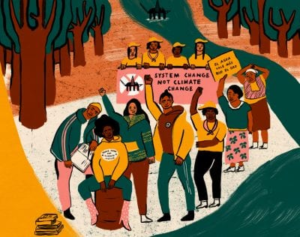» History News: Health in the Disparities Report by Mateo Mérida

Structural racism has been a pervasive problem through much of Charleston’s history. For that reason, in 2015, thanks to a grant from Google, the College of Charleston founded the Race and Social Justice Initiative, which immediately began compiling as much data as it could to statistically qualify how structural racism has impacted Charleston’s Black community. Based on the data from “The State of Racial Disparities in Charleston County, South Carolina 2000-2015,” it is clear that health and wellness is one of the most pervasive issues rooted in the history of structural racism in Charleston.
North Charleston has the highest concentration of Black residents in the whole of Charleston County. It’s also home to an airport, a paper mill, an oil refinery, as well as several highways running through the suburb. The has been a mass exodus of Black Charlestonians from downtown Charleston in recent years due to rapid gentrification of the area. According to the disparities report “Black residents have had to move further away from urban work centers to find affordable housing” after being priced out of historically Black communities downtown. In the North Area, the property value which surrounds these plants, roads, and facilities creates considerably cheaper, more affordable housing that displaced Charlestonians have flocked to. As new condos and freshly renovated properties appear in once Historically Black neighborhoods on and near the peninsula, the rent and property taxes have skyrocketed because of their proximity to downtown Charleston’s commercial district and green spaces and distance from the less desirable, industrialized parts of town.1
The undesirability of properties surrounded by industrial sites is tied to the impact they tend to have on one’s health, as they emphatically degrade air, land, and water quality. “Low-income residents and residents of color in Charleston County continue to live in segregated communities that suffer from greater exposure to environmental hazards that include noxious incinerators, landfills, Superfund sites, Toxics Release Inventory facilities, and sewer and water treatment plants.” Although the City of Charleston no longer has a Black majority, North Charleston is a majority Black city and due to factors like redlining, gentrification, the concentrated poverty of Charleston’s Black population, Black people have few choices but to seek refuge in these poisoned environments.2
Aside from the obvious risks to health associated with occupying the same space as the myriad of industrial sites, “…these stressors, coupled with inadequate health-promoting infrastructure (supermarkets, parks, open spaces, medical facilities), reduce the community’s ability to defend against the adverse health consequences of their differential burden and exposure to eco-hazards.” A community without supermarkets or grocery stores is a community starved. Instead, the alternative is a corner store, which may be helpful for acquiring a gallon of milk, but there are no fruits, vegetables, or quality proteins there. Instead, Black people in North Charleston would need to drive well outside of their communities to acquire quality foods however, most depend on public transportation. North Charleston is a textbook definition of what is called a “food desert.” A food desert is a place in which quality, healthy foods cannot be found in a concentrated area, because there is no place where they can be acquired. According to a 2011 report by the Charleston City Paper, North Charleston contains more than 11 census tracks that fit the criteria for food deserts. Grocery stores are just one example of a lack of health resources, with hospitals, playgrounds, and parks also being equally as lacking.3

Unmistakably, these issues are compounding. There are no places available to help support a healthy lifestyle, because the land is being used by industrial sites. Industrial sites attack the health of people living in the area. People living in the area have no resources to support a healthy lifestyle, so not only is their health under attack at all times, there are also no mechanisms available to defend against the attack to begin with.
As the disparities report has shown, this feedback loop has very real consequences. Charleston’s Black infants “…face a toxic mix of poverty, chronically sick mothers, premature birth, and daunting barriers to health care.” The Disparities Report cites that in 2015, the infant mortality rate for lack children was 11.2 deaths per every 1,000 Black children born. In comparison, the rate was 4.8 for White Charlestonians. The effects of poor health impact Black people of all ages, with Black children being the most susceptible of all.4

Black health is under attack in Charleston. There is no policy that was written by white authorities that explicitly and directly requires Black people to live in a form of medical misery. However, there has been a plethora of policies that were written to promote gentrification, to perpetuate Black poverty, and which permit people to live in ecologically hazardous areas. Racism does not solely mean treating people differently interpersonally because you don’t see them as equals. Instead, racism is a far more prominent phenomena in that it is structural and institutionalized. Racism lives in the laws, corporations, and economy that creates the circumstances which determine who lives where, and how they will live in those places, while ignoring the suffering of vulnerable people.
The disparities report concludes with a number of policy recommendations meant to expel structural racism from Charleston society. Regarding ways to address environmental issues impacting people’s daily lives. It requests that the municipalities should:
Require county government to develop racial equity ‘Inclusion and Integration Plans’ containing explicit, measurable, and time-sensitive objectives aimed at ending exclusion, segregation, and environmental injustice. Each Plan must be developed through an open, public, diverse, and inclusive process involving representatives from all segments of the community—especially from key advocacy organizations representing African Americans and other people of color. A high priority must also be placed on insuring the meaningful participation of low-income people of color.5
To protect people living exhausted by ecological degradation they must be included in the discussions about solutions. Surely, conversations like these would not only include the construction and organization of new hospitals, grocery stores, and community parks in the Charleston area, but this dialogue would also require higher standards for industries in the area to protect the land upon which Black Charlestonians and many of other marginalized groups live. Until those conversations take place, until we stop putting profits before people, Black health and wellness will continue to be under direct attack in Charleston, and structural changes need to be made in order to guarantee a higher quality of life for all of the county’s people.
Sources
- Avery Research Center. The State of Racial Disparities in Charleston County, South Carolina. College of Charleston: Charleston, SC. 2017. pp. 37.
- Ibid, 62.
- Ibid.
- Ibid, 67-68.
- Ibid, 75.
Image Credits
- Avery Research Center. “The State of Racial Disparities in Charleston County, South Carolina, 2000-2015.” College of Charleston: Charleston, SC. 2017. Pp Cover Page.
- Ibid, 62.
- Office of Sustainability. “Environmental Justice.” Institute of the Environment. University of Connecticut: Storrs, CT. Accessed Feb. 4, 2022. https://sustainability.uconn.edu/environmental-justice/#
